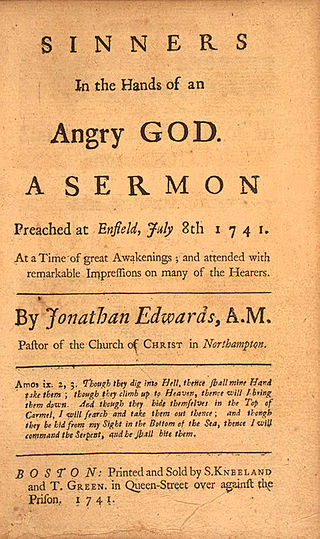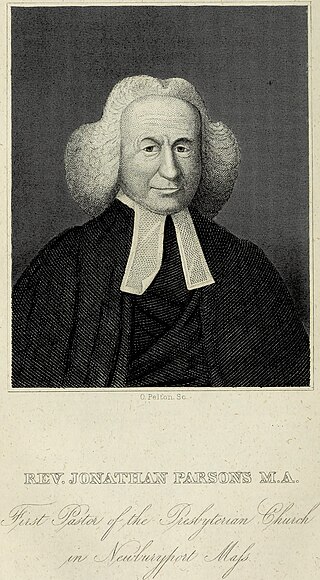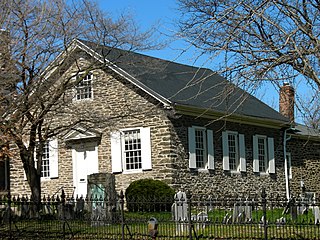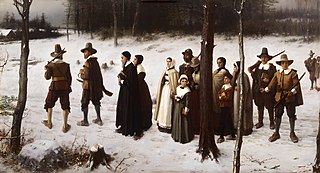Related Research Articles

The Presbyterian Church (USA), abbreviated PC (USA), is a mainline Protestant denomination in the United States. It is the largest Presbyterian denomination in the country, known for its liberal stance on doctrine and its ordaining of women and members of the LGBT community as elders and ministers. The Presbyterian Church (USA) was established with the 1983 merger of the Presbyterian Church in the United States, whose churches were located in the Southern and border states, with the United Presbyterian Church in the United States of America, whose congregations could be found in every state.
Great Awakening refers to a number of periods of religious revival in American Christian history. Historians and theologians identify three, or sometimes four, waves of increased religious enthusiasm between the early 18th century and the late 20th century. Each of these "Great Awakenings" was characterized by widespread revivals led by evangelical Protestant ministers, a sharp increase of interest in religion, a profound sense of conviction and redemption on the part of those affected, an increase in evangelical church membership, and the formation of new religious movements and denominations.

The Second Great Awakening was a Protestant religious revival during the early 19th century in the United States. The Second Great Awakening, which spread religion through revivals and emotional preaching, sparked a number of reform movements. Revivals were a key part of the movement and attracted hundreds of converts to new Protestant denominations. The Methodist Church used circuit riders to reach people in frontier locations.

The Cumberland Presbyterian Church is a Presbyterian denomination spawned by the Second Great Awakening. In 2019, it had 65,087 members and 673 congregations, of which 51 were located outside of the United States. The word Cumberland comes from the Cumberland River valley where the church was founded.
The Separate Baptists are a group of Baptists originating in the 18th-century United States, primarily in the South, that grew out of the Great Awakening.

Religion in the United States began with the religions and spiritual practices of Native Americans. Later, religion also played a role in the founding of some colonies, as many colonists, such as the Puritans, came to escape religious persecution. Historians debate how much influence religion, specifically Christianity and more specifically Protestantism, had on the American Revolution. Many of the Founding Fathers were active in a local Protestant church; some of them had deist sentiments, such as Thomas Jefferson, Benjamin Franklin, and George Washington. Some researchers and authors have referred to the United States as a "Protestant nation" or "founded on Protestant principles," specifically emphasizing its Calvinist heritage. Others stress the secular character of the American Revolution and note the secular character of the nation's founding documents.

The First Great Awakening or the Evangelical Revival was a series of Christian revivals that swept Britain and its thirteen North American colonies in the 1730s and 1740s. The revival movement permanently affected Protestantism as adherents strove to renew individual piety and religious devotion. The Great Awakening marked the emergence of Anglo-American evangelicalism as a trans-denominational movement within the Protestant churches. In the United States, the term Great Awakening is most often used, while in the United Kingdom the movement is referred to as the Evangelical Revival.

The Fourth Great Awakening was a Christian awakening that some scholars – most notably economic historian Robert Fogel – say took place in the United States in the late 1960s and early 1970s, while others look at the era following World War II. The terminology is controversial, with some historians believing the religious changes that took place in the US during these years were not equivalent to those of the first three great awakenings. Thus, the idea of a Fourth Great Awakening itself has not been generally accepted.

The Presbyterian Church in the United States of America (PCUSA) was a Presbyterian denomination existing from 1789 to 1958. In that year, the PCUSA merged with the United Presbyterian Church of North America. The new church was named the United Presbyterian Church in the United States of America. It was a predecessor to the contemporary Presbyterian Church (USA).

Jonathan Parsons was a Christian New England clergyman during the late colonial period and a supporter of the American Revolution. Born in West Springfield, Massachusetts, he was the youngest son of Ebenezer (Deacon) Parsons (1668-1752) and Margaret Marshfield of Springfield. Though intended for an artisan career, the Rev. Jonathan Edwards, then a tutor at Yale, persuaded young Parsons to prepare for college.

The Bible Presbyterian Church is an American Protestant denomination in the Calvinist tradition.
The Saybrook Platform was a new constitution for the Congregational church in Connecticut in 1708. Religious and civic leaders in Connecticut around 1700 were distressed by the colony-wide decline in personal religious piety and in church discipline. The colonial legislature took action by calling 12 ministers and four laymen to meet in Saybrook, Connecticut; eight were Yale trustees. They prepared fifteen articles that theologically put the church in the Westminster theological tradition. It rejected extreme localism or "congregationalism" that had been inherited from England, replacing it with a centralized system similar to Presbyterian polity. The Congregational church was now to be led by local ministerial associations and consociations composed of ministers and lay leaders from a specific geographical area. A colony-wide General Assembly had final authority. Instead of the congregation from each local church selecting its minister, the associations now had the responsibility to examine candidates for the ministry, and to oversee behavior of the ministers. The consociations could impose discipline on specific churches and judge disputes that arose.

The Reformed Presbyterian Church of North America (RPCNA) is a Presbyterian church with congregations and missions throughout the United States, Canada, Japan, and Chile. Its beliefs—held in common with other members of the Reformed Presbyterian Global Alliance—place it in the conservative wing of the Reformed family of Protestant churches. Below the Bible—which is held as divinely inspired and without error—the church is committed to several "subordinate standards," together considered with its constitution: the Westminster Confession of Faith and Larger and Shorter Catechisms, along with its Testimony, Directory for Church Government, the Book of Discipline, and Directory for Worship.

In the United States, evangelicalism is a movement among Protestant Christians who believe in the necessity of being born again, emphasize the importance of evangelism, and affirm traditional Protestant teachings on the authority as well as the historicity of the Bible. Comprising nearly a quarter of the U.S. population, evangelicals are a diverse group drawn from a variety of denominational backgrounds, including Baptist, Mennonite, Methodist, Pentecostal, Plymouth Brethren, Quaker, Reformed and nondenominational churches.

Christianity was introduced with the first European settlers beginning in the 16th and 17th centuries. Colonists from Northern Europe introduced Protestantism in its Anglican and Reformed forms to Plymouth Colony, Massachusetts Bay Colony, New Netherland, Virginia Colony, and Carolina Colony. The first arrivals were adherents to Anglicanism, Congregationalism, Presbyterianism, Methodism, the Baptist Church, Calvinism, Lutheranism, Quakerism, Anabaptism and the Moravian Church from British, German, Dutch, and Nordic stock. America began as a significant Protestant majority nation. Significant minorities of Roman Catholics and Jews did not arise until the period between 1880 and 1910.
Christian revivalism is increased spiritual interest or renewal in the life of a church congregation or society, with a local, national or global effect. This should be distinguished from the use of the term "revival" to refer to an evangelistic meeting or series of meetings. Proponents view revivals as the restoration of the church itself to a vital and fervent relationship with God after a period of moral decline.

Presbyterianism has had a presence in the United States since colonial times and has exerted an important influence over broader American religion and culture.
The Reformed Presbyterian Church, General Synod was a Presbyterian denomination that came about due to a split amongst the Reformed Presbyterians, or Covenanters and existed between 1833 and 1965.

Congregationalism in the United States consists of Protestant churches in the Reformed tradition that have a congregational form of church government and trace their origins mainly to Puritan settlers of colonial New England. Congregational churches in other parts of the world are often related to these in the United States due to American missionary activities.
References
- ↑ Bonomi, Patricia U. (1986). Under the Cope of Heaven: Religion, Society, and Politics in Colonial America. Oxford University Press. pp. 131–67. ISBN 978-0-19-972911-1.
- ↑ Ava Chamberlain, "Self-Deception as a Theological Problem in Jonathan Edwards's 'Treatise Concerning Religious Affections,"' Church History, (1994) 63#4 pp. 541-556 in JSTOR
- ↑ Bushman, Richard L. (1967). From Puritan to Yankee: Character and the Social Order in Connecticut, 1690–1765 . Cambridge, Massachusetts: Harvard University Press. pp. 182–95 & 235–66.
- ↑ Schreiner, Thomas R.; Wright, Shawn (2006). Believer's Baptism: Sign of the New Covenant in Christ. B&H Publishing Group. ISBN 978-0-8054-3249-7.
- ↑ Bonomi, Patricia U. (1986). Under the Cope of Heaven: Religion, Society, and Politics in Colonial America . New York: Oxford University Press. pp. 139–52.
- ↑ Bonomi, Patricia U. (1986). Under the Cope of Heaven: Religion, Society, and Politics in Colonial America . New York: Oxford University Press. p. 139.